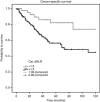Validation of the pretreatment derived neutrophil-lymphocyte ratio as a prognostic factor in a European cohort of patients with upper tract urothelial carcinoma
- PMID: 24691424
- PMCID: PMC4021523
- DOI: 10.1038/bjc.2014.180
Validation of the pretreatment derived neutrophil-lymphocyte ratio as a prognostic factor in a European cohort of patients with upper tract urothelial carcinoma
Abstract
Background: The value of a combined index of neutrophil and white cell counts, named derived neutrophil-lymphocyte ratio (dNLR), has recently been proposed as a prognosticator of survival in various cancer types. We investigated the prognostic role of the dNLR in a large European cohort of patients with upper tract urothelial carcinoma (UTUC).
Methods: Data from 171 non-metastatic UTUC patients, operated between 1990 and 2012 at a single tertiary academic centre, were evaluated retrospectively. Cancer-specific- (CSS) as well as overall survival (OS) were assessed using the Kaplan-Meier method. To evaluate the independent prognostic significance of the dNLR, multivariate proportional Cox-regression models were applied. Additionally, the influence of the dNLR on the predictive accuracy of the multivariate model was further determined by Harrell's concordance index (c-index).
Results: The median follow-up period was 31 months. An increased dNLR was statistically significantly associated with shorter CSS (log-rank P=0.004), as well as with shorter OS (log-rank P=0.002). Multivariate analysis identified dNLR as an independent predictor for CSS (hazard ratio, HR=1.16, 95% confidence interval, CI=1.01-1.35, P=0.045), as well as for OS (HR=1.21, 95% CI=1.09-1.34, P<0.001). The estimated c-index of the multivariate model for OS was 0.68 without dNLR and 0.73 when dNLR was added.
Conclusions: Patients with a high pretreatment dNLR could be predicted to show subsequently higher cancer-specific- as well as overall mortality after surgery for UTUC compared with those with a low pretreatment dNLR. Thus, this combined index should be considered as a potential prognostic biomarker in future.
Figures
References
-
- Clarke SJ, Chua W, Moore M, Kao S, Phan V, Tan C, Charles K, McMillan DC. Use of inflammatory markers to guide cancer treatment. Clin Pharmacol Ther. 2011;90 (3:475–478. - PubMed
-
- Dalpiaz O, Ehrlich GC, Mannweiler S, Hernández JM, Gerger A, Stojakovic T, Pummer K, Zigeuner R, Pichler M, Hutterer GC.2013Validation of the pre-treatment neutrophil-lymphocyte ratio as prognostic factor in a European cohort of patients with upper tract urothelial carcinoma BJU Inte-pub ahead of print 5 September 2013 doi:10.1111/bju.12441 - DOI - PubMed
-
- Drouin SJ, Yates DR, Hupertan V, Cussenot O, Rouprêt M. A systematic review of the tools available for predicting survival and managing patients with urothelial carcinomas of the bladder and of the upper tract in a curative setting. World J Urol. 2013;31 (1:109–116. - PubMed
-
- Fajkovic H, Cha EK, Xylinas E, Rink M, Pycha A, Seitz C, Bolenz C, Dunning A, Novara G, Trinh QD, Karakiewicz PI, Margulis V, Raman JD, Walton TJ, Baba S, Carballido J, Otto W, Montorsi F, Lotan Y, Kassouf W, Fritsche HM, Bensalah K, Zigeuner R, Scherr DS, Sonpavde G, Roupret M, Shariat SF. Disease-free survival as a surrogate for overall survival in upper tract urothelial carcinoma. World J Urol. 2013;31 (1:5–11. - PubMed
Publication types
MeSH terms
LinkOut - more resources
Full Text Sources
Other Literature Sources
Medical



